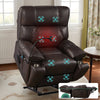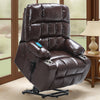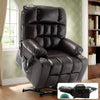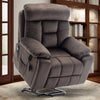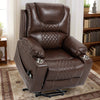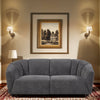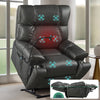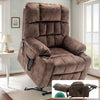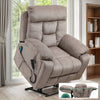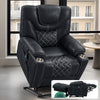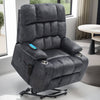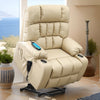The Benefits of Lift Chairs for Elderly Mobility
Understanding the Mechanism of Lift Chairs
Lift chairs are specialized recliners designed to help elderly or mobility-impaired users stand up easily. They use a power-operated mechanism to tilt forward and lift upward. This motion gently raises the user to a near-standing position. The chair's base remains stable, providing support throughout the process. Most lift chairs have multiple reclining positions for comfort. They also offer various lifting angles to suit different user needs. The controls are usually simple, with large buttons for easy operation by seniors.

Why Lift Chairs are More Accessible for the Elderly
Lift chairs offer several advantages for elderly users with mobility issues. They reduce the strain on joints and muscles when standing up or sitting down. This can be especially helpful for those with arthritis, back pain, or weak leg strength. Lift chairs promote independence, allowing seniors to move without assistance. They also reduce the risk of falls, a common concern for older adults. The smooth, controlled motion of lift chairs provides a sense of security. Many users report feeling more confident in their daily activities when using these chairs.
Improving Quality of Life with Lift Chairs
Lift chairs can significantly enhance the quality of life for aging adults. They allow seniors to maintain their independence longer, boosting self-esteem and mental well-being. The chairs enable easier participation in daily activities, from watching TV to reading. This increased engagement can help prevent isolation and depression. Some lift chairs come with added features like heat and massage, offering extra comfort. These features can help alleviate pain and improve circulation. By making sitting and standing easier, lift chairs encourage more movement throughout the day.
Traditional Recliners vs. Lift Chairs: A Comparative Analysis
Key Differences in Design and Functionality
Traditional recliners and lift chairs share some similarities but have key differences. Both offer comfortable seating and reclining positions. However, lift chairs have a power-operated lifting mechanism, while traditional recliners do not. Lift chairs often have more positioning options, including zero-gravity and Trendelenburg positions. Traditional recliners typically have manual controls, while lift chairs use electric motors. Lift chairs are designed with safety features like backup batteries and smooth operation. Traditional recliners may require more physical effort to operate, especially when closing the footrest.

The Pros and Cons for Elderly Users
Lift chairs offer clear advantages for elderly users with mobility issues:
- Easier standing and sitting
- Reduced risk of falls
- Promote independence
- Often include therapeutic features
However, they also have some drawbacks:
- Higher cost
- Require electricity
- Can be bulky
Traditional recliners have their own set of pros and cons:
Pros:
- Generally less expensive
- No need for electrical outlet
- Familiar design
Cons:
- May be difficult to exit for those with mobility issues
- Limited positioning options
- Can strain joints when closing footrest
Ease of Use and User Satisfaction
Lift chairs are generally easier for elderly users to operate. The power controls are simple and require little physical effort. Many users report high satisfaction with lift chairs, citing increased independence and comfort. Traditional recliners may be more challenging for some seniors to use. The manual controls can be difficult for those with arthritis or limited strength. However, some users prefer the familiar feel of traditional recliners. User satisfaction often depends on individual needs and preferences.
Best Practices for Choosing Lift Chairs or Traditional Recliners
Assessing Individual User Needs
Choosing between a lift chair and a traditional recliner depends on the user's specific needs. Consider the following factors:

- Mobility level: Those with significant mobility issues may benefit more from lift chairs.
- Physical strength: Users with limited strength might struggle with manual recliners.
- Health conditions: Certain conditions like arthritis or back pain may influence the choice.
- Living situation: Consider whether the user lives alone or has caregiver support.
- Personal preferences: Some may prefer the look or feel of traditional recliners.
It's important to involve the user in the decision-making process. Try different options if possible before making a choice.
Evaluating the Cost and Value Proposition
Cost is an important factor when choosing between lift chairs and traditional recliners. Lift chairs are generally more expensive due to their advanced features. However, they may offer better long-term value for users with mobility issues. Consider the potential savings in caregiver costs or medical expenses. Traditional recliners are usually more affordable upfront. They may be a good choice for those with minimal mobility concerns. When evaluating cost, factor in durability, warranty, and potential repair needs. Some insurance plans may cover part of the cost for lift chairs if medically necessary.
Safety and Ergonomic Considerations in the United States
Safety is paramount when choosing seating for elderly adults. In the United States, look for chairs that meet safety standards set by organizations like the FDA. Lift chairs should have smooth, controlled motions to prevent jerky movements. Look for models with backup battery power in case of electrical outages. Ergonomic design is crucial for both lift chairs and traditional recliners. Ensure the chair provides proper lumbar support and fits the user's body size. Consider features like adjustable headrests and arm heights for maximum comfort. Non-slip upholstery can add an extra layer of safety. Always check weight capacity to ensure the chair can support the user safely.








